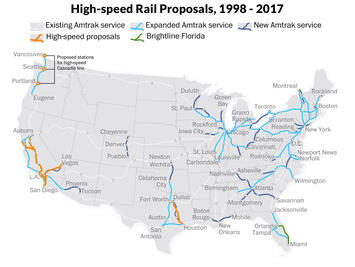
The Mineta Institute — named after a San Jose congressman who was Secretary of Transportation in 2001 through 2006 — has a new report claiming that high-speed rail will produce huge economic and environmental benefits. Rather than being based on any careful analyses, it basically repeats old claims that are even less valid today than when they were first made. Click here to download a PDF of this report.
For example, the report cites the California High-Speed Rail Authority’s claim that rail construction “has generated an estimated 74,000 to 80,000 job years, $5.6 to $6.0 billion in labor income, and $15 billion to $16 billion in economic output between 2006 and 2022.” That’s like saying that buying a $100,000 car generates $100,000 in income. It might be income for someone, but for the person buying, the $100,000 is a cost, not a revenue.
This is a particularly vital point today when the nation is suffering from what looks like will be an indefinite labor shortage. Every person who is put to work building money-losing high-speed rail lines takes away someone who could be building homes to reduce the housing crisis or doing lots of other work for for-profit enterprises. By exacerbating the labor shortage, high-speed rail is increasing consumer costs as well as taxes.
The report also claims that “Multiple studies show that HSR in the U.S. could connect megaregions, forming the corridors of housing, employment, and recreation in more densely populated areas of the country.” Notice the word “could.” We heard the same claims about light rail only to find that the only economic development generated by light rail was development that was subsidized. The reality is that people no longer want to live in “densely populated areas” if they ever did, so building high-speed rail between those areas superfluous.
The Mineta report also cites a study that claimed “that it would cost an estimated $122-199 billion to provide the equivalent highway and airport capacity that the San Francisco to Los Angeles high-speed rail network would provide.” This was an absurd study done for the California high-speed rail project that assumed that the only alternative to high-speed rail was to add new freeway lanes in the entire corridor, even in areas that weren’t congested, and to greatly expand airport capacity when the airlines could carry more passengers without expanded airports simply by flying larger planes.
I’ve said it before and I’ll say it again: high-speed rail was made obsolete before Japan laid the first Shinkansen rail, back in 1958 when Boeing introduced the 707 and Douglas the DC-8. These planes could cruise four times as fast as the Shinkansen’s top speed and twice as fast as the fastest trains today. While today’s airports are pretty elaborate affairs paid for by passenger fees, the only infrastructure jet airlines really need is a paved landing field with stairways that can be rolled up to the planes.
In particular, airliner don’t need hundreds of miles of high-cost roadbeds that must be built and maintained to high-precision standards. This is why 2022 airline fares averaged 20¢ per passenger-mile while fares on Amtrak’s Acela averaged 81¢ per mile — and the airlines came closer to making a profit than the Acela.
Read the rest of this piece at The Antiplanner.
Randal O'Toole, the Antiplanner, is a policy analyst with nearly 50 years of experience reviewing transportation and land-use plans and the author of The Best-Laid Plans: How Government Planning Harms Your Quality of Life, Your Pocketbook, and Your Future.
Photo: chart from the report cover.













Mineta Transportation Institute
Would like to read more about this operation. Report says it is publicly and privately funded, and associated with San Jose State Univ.